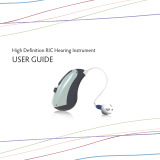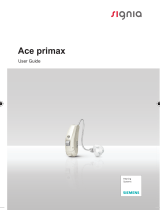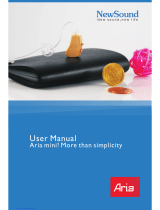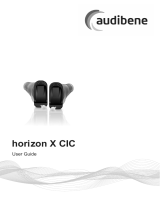Page is loading ...

USER GUIDE
REMOTE MICROPHONE

2 3
Intended use
Generic air-conduction hearing instruments are wearable sound-amplifying devices intended to compen-
sate for impaired hearing. The fundamental operating principle of hearing instruments is to receive, amplify,
and transfer sound to the eardrum of a hearing impaired person.
Introduction
Congratulations on the purchase of your new hearing instruments. ReSound’s innovative
sound technology and design, combined with the customized programming selected by your hear-
ing care professional, will make hearing a more enjoyable experience. Hearing instruments will en-
able you to hear sounds that you may not have heard in years because of your hearing loss. Prac-
tice and a positive attitude are important in learning to use hearing instruments. Your ReSound
instruments have been adjusted according to your individual hearing loss and needs. Some people
adjust quickly to wearing hearing instruments in their ears and hearing new sounds; other
people may need more time.
Please read this manual carefully in order to wholly benefit from the use of your hearing instruments. With
proper care, maintenance, and usage, your hearing instruments will aid you in better communication for
many years. Ask your hearing care professional if you have any questions.
Hearing instrument model:
Battery size 10
Tube size:
Dome size:
Left serial number:
Right serial number:
ReSound is a registred trademark of GN ReSound A/S

4 5
Intended use ...........................2
Introduction ............................2
The parts of your hearing instrument .........6
Switching on and off .....................7
SmartStart.............................7
Changing batteries.......................8
Low battery indicator .....................9
Inserting the hearing instrument .............9
Removing the hearing instrument ...........11
Telephone use ........................11
Listen to radio or TV ....................12
Cellular phones ........................12
Care and maintenance...................13
Daily maintenance ......................14
The microphone tube....................14
Wax filter .............................14
To replace the wax filter ..................14
How to apply domes ....................16
General precautions.....................16
General warnings.......................16
Battery warning information ...............17
Important notice for prospective
hearing aid users (US only)................18
Children with hearing loss (US only) .........19
Warning to hearing aid dispensers (US only) ...19
Troubleshooting guide ...................20
Technical data .........................24
Warranty and repairs ....................24
Temperature test, transport, and
storage information......................25
Contents

1
1
8
2
3
3
4
5
5
7
7
6
6
1
1
8
2
3
3
4
5
5
7
7
6
6
6 7
Instant fit remote mic hearing instrument models with size 10A battery are available in following variants:
LX800-M and LX400-M
The parts of your hearing instrument
1. Body
2. Sound Outlet/Receiver (under wax filter)
3. Wax Filter
4. Battery Door
5. Microphone Tubing
6. Microphone
7. Microphone Outlets
8. Model and Serial Number
Switching on and off
Your instrument is equipped with an on/off switch integrated into the battery
compartment. When the battery compartment is fully closed, the instru-
ment is turned on.
To turn the instrument off, grasp the battery compartment door with your
fingernail and gently pull downwards. The power will switch off at the point
where you can feel a small click.
At night, switch off your instrument and open the battery door completely.
It allows moisture in your instrument to evaporate and will increase the instrument’s life
span.
i
Switch your instrument off if you are not using it. This will increase the battery life.
After switching on the device, the volume will be as set by your hearing care practitioner. Read more on
this subject on page 22.
SmartStart
Hearing instruments can be turned on once you have placed them on your ears. If you prefer to turn them
on just prior to placing them on your ear, your hearing care professional can activate a function called
SmartStart. This function will delay the time in which the hearing instruments turn on by several seconds
after the battery compartment is closed. With SmartStart, a beep will be heard for each second of the
delay period.

RIGHT (RED)LEFT (BLUE)
LEFT (BLUE) RIGHT (RED)
8 9
Changing batteries
When the battery voltage/power decreases to a certain level, the instrument will emit a soft beeping signal.
This signal will continue for about one minute, and the sequence will continue every five minutes until the
instrument will be automatically switched off. It is therefore advisable to keep an extra battery on hand.
• Remove the protective seal from the fresh battery and
insert it in the battery door, with the plus side facing up.
You will recognize the plus side of the battery because
it is marked with a ‘+’. Check whether the ‘+’ symbols
on the battery and on the battery door are on the same
side.
• Always insert a battery in the opened door, never di-
rectly into the instrument.
• A new battery should be inserted into the battery compartment with the microphone tubing pointed
up.
Close the battery door. This should go smoothly, so never force it as this could damage
your instrument.
i Remove the batteries to prevent battery leakage or corrosion when the hearing instruments are not
in use for an extended period of time.
i
Always use new Zinc-Air batteries that have a minimum remaining shelf-life of 1 year.
Low battery indicator
Your hearing care professional can activate a low battery indicator in your hearing instruments. The hear-
ing instrument will reduce amplification and play a melody if battery power gets too low. This signal will
recur every five minutes until the hearing instrument automatically switches off. The timing of the low bat-
tery indicator can vary slightly, depending on the type of battery used. It is recommended that you keep
spare batteries on hand.
Inserting the hearing instrument
1. Determine if you have a left or right instrument in
your hand. At the tip of the device, or with the battery
compartment open, you will see either a RED or BLUE
marker:
• The hearing instrument with the RED marker is always
for the RIGHT ear.
• The hearing instrument with the BLUE marker is always
for the LEFT ear.
2. Check that the body of the hearing instrument feels
smooth before inserting into your ear canal. If the surface
feels spiky or rough, contact your hearing care profes-
sional.
3. Grasp the instrument near the base where the tubing
connects to the battery compartment, with your index
finger on top and your thumb on bottom.

10 11
Notice that the battery door is pointing up. This is the correct way to insert the instrument.
4. When properly lined up, gently push the hearing instru-
ment into the ear canal until it is flush with the opening
of the ear canal.
5. After the hearing instrument has been properly seated
in the ear canal, locate microphone and tubing.
6. Gently push the microphone into the creased area of
the ear that is located above the ear canal entrance.
7. After the microphone is in place, push the tubing into
place.
8. This drawing shows how the hearing instrument should
look when inserted properly into the ear canal. It is im-
portant that the microphone tube fits correctly in your
ear. If the microphone tube irritates your ear,
please contact your hearing care professional.
Removing the hearing instrument
1. Find the microphone and tubing in the crease of the ear that
is located above the ear canal entrance.
2. Once you have located the tubing, GENTLY grasp and pull,
and the hearing instrument should come out of the ear.
3. Each time the hearing instrument is removed from the ear
canal, make sure that the wax filter is still attached to the
instrument. If not, contact your hearing care professional
immediately.
Telephone use
Should you experience any feedback or whistling while trying to
talk on the telephone, you can avoid this by taking the following precautions:
• Hold your telephone handset close to the lower part of the ear, and firmly push it
towards the outside of the ear canal.
• Listen to the dialing tone and move the handset a little to find the position that give
the best reception.
• The best position to hold a telephone may be determined by the shape of telephone
you are using.
By employing these techniques while using the instrument on the telephone, you will be
able to minimize feedback and keep your listening experience enjoyable.

12 13
Listen to the radio or TV
When listening to the TV or the radio, start out by listening to news commentators since they usually speak
clearly, then try other programs.
If you find it difficult to listen to TV or radio, your hearing care professional will be able to give you advice on
available accessories to enhance your listening capabilities for TV and radio.
Cellular phones
Your hearing instrument is designed to comply with the most stringent Standards of International Electro-
magnetic Compatibility. However, not all cell phones are hearing instrument compatible. The varying degree
of disturbance can be due to the nature of your particular cellular phone or of your wireless telephone
service provider.
If you find it difficult to obtain a good result while using your cellular phone, your hearing care
professional will be able to give you advice on available accessories to enhance listening
capabilities.
i
Care and maintenance
Proper handling
Your hearing instrument is protected by a layer of protective, hydrophobic nanocoat material. However, please
follow these instructions to further prolong the durability of your hearing instruments.
1. Keep your hearing instrument clean and dry. Wipe the case with a soft cloth or tissue after use to re-
move grease or moisture. Do not use water or solvents, as these can damage the hearing instrument(s).
2. Never immerse hearing instruments in water or other liquids, as liquids may cause permanent damage
to the hearing instruments.
3. Avoid rough handling of hearing instruments or dropping them on hard surfaces or floors.
4. Do not leave hearing instruments in or near direct heat or sunlight, such as in a hot, parked car, as
excessive heat can cause damage or deform the casing.
5. Hairspray, make-up, etc. may damage hearing instruments. Remove the instruments prior to the ap-
plication of cosmetics.
6. Never force the battery door closed, as this may damage the hearing instrument.
7. Do not leave hearing instruments in the sun, near an open fire, or in a hot, parked car.
8. Do not wear hearing instruments while showering, swimming, in heavy rain, or in a moist atmosphere
such as a steam bath or sauna.
9. If your instrument does get wet, or if it has been exposed to high humidity or perspiration, it should be
left to dry out overnight with the battery out and the battery compartment open.
10. It is also a good idea to put the instrument and battery in a sealed container together with a drying
agent (desiccator) overnight. Do not use the instrument until it is completely dry. Consult your hearing
care professional as to which drying agent to use.
11. Remove the hearing instruments when applying items such as cosmetics, perfume, aftershave, hair-
spray, and suntan lotion.

14 15
i
Daily maintenance
It is important to keep your hearing instrument clean and dry. On a daily basis, clean the hearing instruments
using a soft cloth or tissue. In order to avoid damage due to humidity or excessive perspiration, the use of
a drying kit is recommended.
i
The microphone tube
The microphone tip and tubing can be cleaned by gently wiping them with a soft dry cloth. This will help to
ensure that the ports stay open and allow sound to get into the microphone.
Note that the tube may wear out or become discolored over time with usage of the hearing instrument.
Should the tubing become discolored or should the hearing instrument fail to produce sound, contact your
hearing care professional to have the tubing replaced.
Wax filter
The wax filter is located at the receiver end of the hearing instrument. This filter is designed to decrease the
likelihood that wax will get into the instrument’s sound outlet and cause decreased performance or dam-
age. It is recommended that these are changed as needed.
To replace the wax filter:
1. Remove the dome from the instrument.
2. Clean the device.
3. Use the skewer side of the wax removal tool to remove wax filter.
4. Screw the tool onto the wax filter.
5. Remove the old wax filter.
6. Place the old wax filter in the center of the wax filter wheel.
7. Pull to the side and pull the tool to remove old wax filter.
8. Use the other end of the wax filter tool to get a new wax filter.
9. Remove the wax filter tool and ensure a new wax filter is attached to the tool.
10. Place the new wax filter on the device.
11. Turn the device back and forth and remove. Ensure the new wax filter sticks to the device.
12. Put on the dome.
Note: It is not recommended that wax filters be reused, as wax filters may not reattach securely.

16 17
How to apply domes
It is recommended that your hearing care professional change domes, as incorrect
dome replacement could result in the dome falling out in the ear.
1. Push the new dome over the tip of the instrument.
2. Make sure that the new dome is properly and securely mounted.
i General precautions
1. You should never attempt to modify the shape of the microphone tube yourself.
2. Use only original GN ReSound consumables e.g. tubes and domes.
i General warnings
1. Consult a hearing care professional if you think there may be a foreign object in your ear canal, if you
experience skin irritation, or if excessive earwax accumulates with the use of the hearing instrument.
2. Different types of radiation, from e.g. NMR, MRI, or CT scanners, may damage hearing instruments.
It is recommended not to wear hearing instruments during these or other similar procedures. Other
types of radiation, such as burglar alarms, room surveillance systems, radio equipment, mobile
telephones, contain less energy and will not damage hearing instruments. However, they have the
potential to momentarily affect the sound quality or temporarily create strange sounds from hearing
instruments.
3. Do not wear hearing instruments in mines, oil fields, or other explosive areas unless those areas are
certified for hearing instrument use.
4. Do not allow others to use your hearing instruments. This may cause damage to the hearing instru-
ments or to the hearing of the other individual.
5. Hearing instruments should be used only as prescribed by your hearing care professional. Incorrect
use may result in hearing loss.
6. Warning: If device is broken, DO NOT USE.
7. Instrument usage by children or mentally challenged persons should be supervised at all times to
ensure their safety.
8. The hearing instrument contains small parts that could be swallowed by children. Please be mindful
not to leave children unsupervised with this hearing instrument.
9. External devices connected to the electrical input must be safe according to the requirements of IEC
60601-1-1, IEC 60065, or IEC 60950-1, as appropriate.
i Battery warning information
Batteries, although very small, contain dangerous substances and should be disposed of carefully. This is
for the safety of you and the environment. Please note:
10. DO NOT attempt to recharge standard zinc air batteries. They may leak or explode.
11. DO NOT attempt to dispose of batteries by burning them.
12. DO NOT place batteries in your mouth. Consult a physician immediately if a battery has been swal-
lowed, as they can be harmful to your health.
13. Keep batteries away from pets, children, and individuals who are mentally challenged.
14. Used batteries are harmful to the environment. Please dispose of them according to local
regulations or return them to your hearing care professional.

18 19
Important Notice for Prospective Hearing Aid Users (US only)
Good health practice requires that a person with a hearing loss have a medical evaluation by a licensed
physician (preferably a physician who specializes in diseases of the ear) before purchasing a hearing aid.
Licensed physicians who specialize in diseases of the ear are often referred to as otolaryngologists, otolo-
gists, or otorhinolaryngologists. The purpose of the medical evaluation is to assure that all medically treat-
able conditions that may affect hearing are identified and treated before the hearing aid is purchased.
Following the medical evaluation, the physician will give you a written statement that states that your hear-
ing loss has been medically evaluated and that you may be considered a candidate for a hearing aid. The
physician will refer you to an audiologist or a hearing aid dispenser, as appropriate, for a hearing aid evalu-
ation. The audiologist or hearing aid dispenser will conduct a hearing aid evaluation to assess your ability
to hear with and without a hearing aid. The hearing aid evaluation will enable the audiologist or dispenser
to select and fit a hearing aid to your individual needs. If you have reservations about your ability to adapt
to amplification, you should inquire about the availability of a trial-rental or purchase-option program. Many
hearing aid dispensers now offer programs that permit you to wear a hearing aid for a period of time for a
nominal fee after which you may decide if you want to purchase the hearing aid. Federal law restricts the
sale of hearing aids to those individuals who have obtained a medical evaluation from a licensed physician.
Federal law permits a fully informed adult to sign a waiver statement declining the medical evaluation for
religious or personal beliefs that preclude consultation with a physician. The exercise of such a waiver is not
in your best health interest, and its use is strongly discouraged.
A hearing aid will not restore normal hearing and will not prevent or improve a hearing impairment resulting
from organic conditions.
The use of a hearing aid is only part of hearing rehabilitation and may need to be supplemented by auditory
training and instructions in lip-reading.
Consistent use of the aid is recommended. In most cases, infrequent use does not permit you to attain full
benefit from it.
Children with hearing loss (US only)
In addition to seeing a physician for a medical evaluation, a child with a hearing loss should be directed
to an audiologist for evaluation and rehabilitation because hearing loss may cause problems in language
development and the educational and social growth of a child. An audiologist is qualified by training and
experience to assist in the evaluation and rehabilitation of a child with hearing loss.
i Warning to Hearing Aid Dispensers (US only)
A hearing aid dispenser should advise a prospective hearing aid user to consult promptly with a licensed
physician (preferably an ear specialist) before dispensing a hearing aid if the hearing aid dispenser de-
termines through inquiry, actual observation, or review of any other available information concerning the
prospective user that the prospective user has any of the following conditions:
(i) Visible congenital or traumatic deformity of the ear.
(ii) History of active drainage from the ear within the previous 90 days.
(iii) History of sudden or rapidly progressive hearing loss within the previous 90 days.
(iv) Acute or chronic dizziness.
(v) Unilateral hearing loss of sudden or recent onset within the previous 90 days.
(vi) Audiometric air-bone gap equal to or greater than 15 decibels at 500 hertz (Hz), 1,000 Hz, and 2,000 Hz.
(vii) Visible evidence of significant cerumen accumulation or a foreign body in the ear canal.
(viii) Pain or discomfort in the ear.

20 21
TROUBLESHOOTING GUIDE
SYMPTOM CAUSE POSSIBLE REMEDY
Hearing instrument
is dead
Not turned on Turn on
Battery is dead Replace battery
Battery improperly inserted Reinsert battery properly
Blocked wax filter Consult your hearing care professional or, if you have been instructed to do so, change the wax filter
Broken receiver Consult your hearing care professional
Broken microphone or microphone tube Consult your hearing care professional
Not clear, distorted
Weak battery Replace battery
Poor fitting microphone tube Consult your hearing care professional
Hearing instrument is damaged Consult your hearing care professional

22 23
If there are any other problems not mentioned in this guide, or should questions arise, please contact your
hearing care professional.
TROUBLESHOOTING GUIDE
SYMPTOM CAUSE POSSIBLE REMEDY
Excessive whistle from instrument
Hearing aid not properly inserted Reinsert carefully
Microphone not properly seated Reseat carefully
With telephone use Review ”Telephone Use” section
Instrument settings not at optimum Consult your hearing care professional
Not loud enough
Hearing aid not properly inserted Reinsert carefully
Microphone not properly seated Reseat carefully
Blocked wax filter Consult your hearing care professional or, if you have been instructed to do so, change the wax filter
Instrument settings not at optimum Consult your hearing care professional
Excessive earwax Consult your physician
Change in hearing Consult your hearing care professional

24 25
Technical data
Hearing Instrument
Model
Maximum output
2cc Coupler / IEC 60118-7
LX800-M, LX400-M 106 dB SPL (typical)
Warranty and repairs
ReSound provides a warranty on hearing instruments in the event of defects in workmanship or materials,
as described in applicable warranty documentation.
In its service policy, ReSound pledges to secure functionality at least equivalent to the original
hearing instrument.
As a signatory to the United Nations Global Compact initiative, ReSound is committed to doing this in line
with environment-friendly best practices. Hearing instruments therefore, at ReSound’s discretion, may be
replaced by new products or products manufactured from new or serviceable used parts, or repaired using
new or refurbished replacement parts.
The warranty period of hearing instruments is designated on your warranty card, which is provided by your
hearing care professional.
For hearing instruments that require service, please contact your hearing care professional for
assistance. If this is not possible, send the instrument to the manufacturer or distributor address on the
back of the User Guide. Proof of purchase may be required.
ReSound hearing instruments that malfunction must be repaired by a qualified technician. Do not attempt
to open the case of hearing instruments, as this will invalidate the warranty.
Temperature test, transport, and storage information
GN ReSound Hearing Instruments are subjected to various tests in temperature and damp heating cycling
between -25C (-13F) and +70C (+158F) according to internal and industry standards.
During transport or storage, the temperature should not exceed the limit values of -20C (-4F) to +60C
(+140F) and relative humidity of 90% RH, non-condensing (for limited time). The air pressure between 500
and 1100 hPa is appropriate.

Please ask your local hearing care professional
concerning disposal of your hearing instrument
26 27
Be aware of information marked with the warning symbol
i WARNING points out a situation that could lead to serious injuries
CAUTION indicates a situation that could lead to minor and moderate injuries
i
Advice and tips on how to handle your hearing instrument better

17982811-US-13.06-Rev.A
ReSound North America
8001 Bloomington Freeway
Bloomington, MN 55420
1-888-735-4327
ReSound Government Services
8001 Bloomington Freeway
Bloomington, MN 55420
1-800-392-9932
ReSound Canada
303 Supertest Road
Toronto, Ontario M3J 2M4
1-888-737-6863
/







